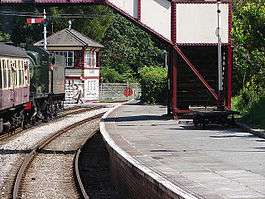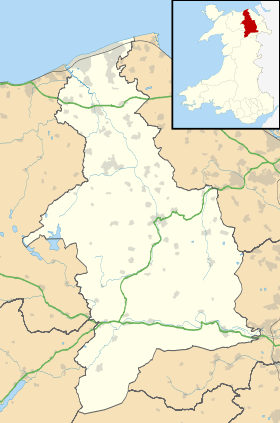Glyndyfrdwy
| Glyndyfrdwy | |
 Glyndyfrdwy railway station |
|
 Glyndyfrdwy |
|
| OS grid reference | SJ149427 |
|---|---|
| Community | Corwen |
| Principal area | Denbighshire |
| Country | Wales |
| Sovereign state | United Kingdom |
| Post town | CORWEN |
| Postcode district | LL21 |
| Dialling code | 01490 |
| Police | North Wales |
| Fire | North Wales |
| Ambulance | Welsh |
| EU Parliament | Wales |
| UK Parliament | Clwyd South |
| Welsh Assembly | Clwyd South |
|
|
Coordinates: 52°58′30″N 3°16′01″W / 52.975°N 3.267°W
Glyndyfrdwy (Welsh pronunciation: [ɡlɨnˈdəvrdʊɨ]), or sometimes Glyn Dyfrdwy, is a village in the modern county of Denbighshire, Wales. It is situated on the A5 road halfway between Corwen and Llangollen in the Dee Valley (the river Dee is Afon Dyfrdwy in Welsh).
Owain Glyndŵr
Historically, the village is renowned for its association with Owain Glyndŵr. Near this village, at his manor of Glyndyfrdwy, Owain Glyndŵr (the Baron of Glyndyfrdwy) proclaimed himself Prince of Wales on 16 September 1400, so beginning his fourteen-year rebellion against English rule.
The eroded remains of a 12th-century castle motte, known locally as Owain Glyndŵr's Mount (probably a corruption of mwnt meaning "motte"), was built to command the route through the Dee Valley. Owain's manor is likely to have been in the square moated area across a nearby field. This would have been defended by a water-filled moat, a palisade and a gate.
The site was devastated in 1403 by the forces of Harry of Monmouth, English Prince of Wales, who later became King Henry V.
In the Owain Glyndŵr Memorial Hall are artifacts associated with the man himself: a copy of the Pennal Letter to King Charles VI of France, a document of 1405 ratifying the terms of a 1404 treaty between Owain and the French, a letter confirming the appointments of Owain's Chancellor, Gruffydd Young and Owain's brother-in-law, John Hanmer as Ambassadors to the French Court, pictures of the Parliament house in Dolgellau, a portrait drawn from Owain's seal, and a replica of this seal.
The Parish
The parish of Glyndyfrdwy was created in 1866 from the former Corwen townships of Carrog, Mwstwr and Tir Llanerch, along with portions of Bonwm and Rhagat. The parish was in the traditional county of Merionethshire until 1974 when it became part of the short-lived county of Clwyd. Following further local government reorganisation in 1996 it is now in the "new" county of Denbighshire.
The Railways
The Great Western Railway line from Ruabon to Llangollen was extended via Corwen, Llanuwchllyn and Dolgellau to Barmouth. Glyndyfrdwy railway station was opened in 1866 and, later, a passing loop and second platform were added there. The line was closed in the 1960s under the Beeching Axe and Glyndyfrdwy station was eventually demolished. In 1977 a group of railway enthusiasts came together to form the Llangollen Railway, with the intention to restore and rebuild a large section of the line. The work was undertaken in stages and by 1991 the track had been replaced as far as Glyndyfrdwy. On 17 April 1992 the first Llangollen Railway passenger train arrived at Glyndyfrdwy.
Glyndyfrdwy was also the terminus of the Deeside Tramway, a narrow gauge railway built to serve the local slate quarries. The tramway was one of the last operating industrial railways in Britain that used wooden rails.
External links
| Wikimedia Commons has media related to Glyndyfrdwy. |
